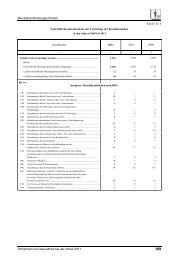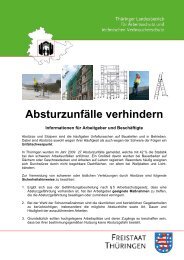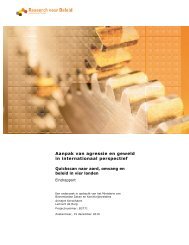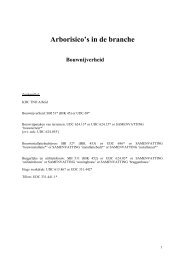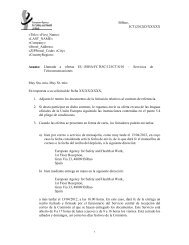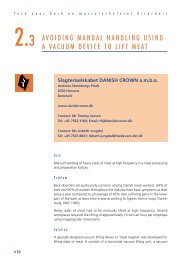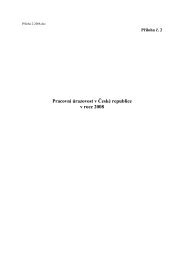ESENER-PSR 2009 - European Agency for Safety and Health at Work
ESENER-PSR 2009 - European Agency for Safety and Health at Work
ESENER-PSR 2009 - European Agency for Safety and Health at Work
You also want an ePaper? Increase the reach of your titles
YUMPU automatically turns print PDFs into web optimized ePapers that Google loves.
2. The address registers<br />
2.1. Types of address-registers<br />
In a preliminary study <strong>for</strong> the first establishment survey of the <strong>European</strong> Found<strong>at</strong>ion <strong>for</strong> the<br />
Improvement of Living <strong>and</strong> <strong>Work</strong>ing Conditions (ESWT 2004), Hermann Groß st<strong>at</strong>ed th<strong>at</strong> “(…)<br />
it is recommendable to take the most recent <strong>and</strong> most comprehensive directory of all<br />
establishments with 1 or more employees in the countries under investig<strong>at</strong>ion" (Groß 2003, p.<br />
13).<br />
This <strong>at</strong> the first glance simple <strong>and</strong> obvious dem<strong>and</strong> is not as easy to fulfil as it might seem. In<br />
most countries there is absolutely no choice between different registers of establishments <strong>and</strong><br />
in several countries there is no establishment register available <strong>at</strong> all. Nevertheless, topicality<br />
<strong>and</strong> comprehensiveness are important criteria of judging the quality of an address source.<br />
Topicality<br />
Topicality was not a real problem with any of the registers used <strong>for</strong> the <strong>ESENER</strong> with certain<br />
limit<strong>at</strong>ions regarding the registers used <strong>for</strong> Turkey. Most of the registers used <strong>for</strong> the <strong>ESENER</strong><br />
<strong>2009</strong> claim to be upd<strong>at</strong>ed <strong>at</strong> least once a year, many even quarterly or weekly. Experiences<br />
have however shown th<strong>at</strong> the scope <strong>and</strong> quality of the upd<strong>at</strong>es varies widely: While some<br />
registers are up-d<strong>at</strong>ed by regularly contacting all listed establishments - e.g. via telephone<br />
interviews or via mail-questionnaires – in other cases up-d<strong>at</strong>es are made <strong>for</strong> those units only<br />
which report changes on their own initi<strong>at</strong>ive. In some registers claiming to be upd<strong>at</strong>ed on a<br />
regular basis, firms which are dissolved or go bankrupt are not de-registered <strong>at</strong> all. Also,<br />
significant increases or decreases of the work<strong>for</strong>ce are often not reported to the institution<br />
responsible <strong>for</strong> maintaining the address-register. The share of quality neutral non responses<br />
(e.g. establishments where the indic<strong>at</strong>ed telephone number was wrong or inactive) <strong>and</strong> the<br />
devi<strong>at</strong>ions between the number of employees as indic<strong>at</strong>ed in the address source <strong>and</strong> the<br />
number of employees according to the survey results are important measures <strong>for</strong> judging on<br />
the topicality of an address source.<br />
Comprehensiveness of sector coverage<br />
With regard to comprehensiveness, a judgement of the different sources is quite difficult. The<br />
total number of entries e.g. is only a very weak indic<strong>at</strong>or <strong>for</strong> the completeness of an addressregister<br />
as long as the register does not embark all establishments in the country. If the l<strong>at</strong>ter<br />
is not the case, entries might be concentr<strong>at</strong>ed on specific types of establishments. For<br />
example there might be a good coverage of large establishments, but an only poor coverage<br />
of the smaller ones (or vice versa). Or registers might be complete <strong>for</strong> certain sectors of<br />
activity but include only very few addresses of others. Other possible criteria <strong>for</strong> inclusion or<br />
exclusion of establishments can be their legal st<strong>at</strong>us, their geographical loc<strong>at</strong>ion within the<br />
country, the amount of turnover, the fact whether they are paying taxes to the n<strong>at</strong>ional tax<br />
office or whether or not they are enrolled in the trade-register.<br />
It is not essential <strong>for</strong> a survey of this kind th<strong>at</strong> an address-register has a complete listing of all<br />
existing addresses of establishments (with 10 or more employees) – although this of course<br />
20





